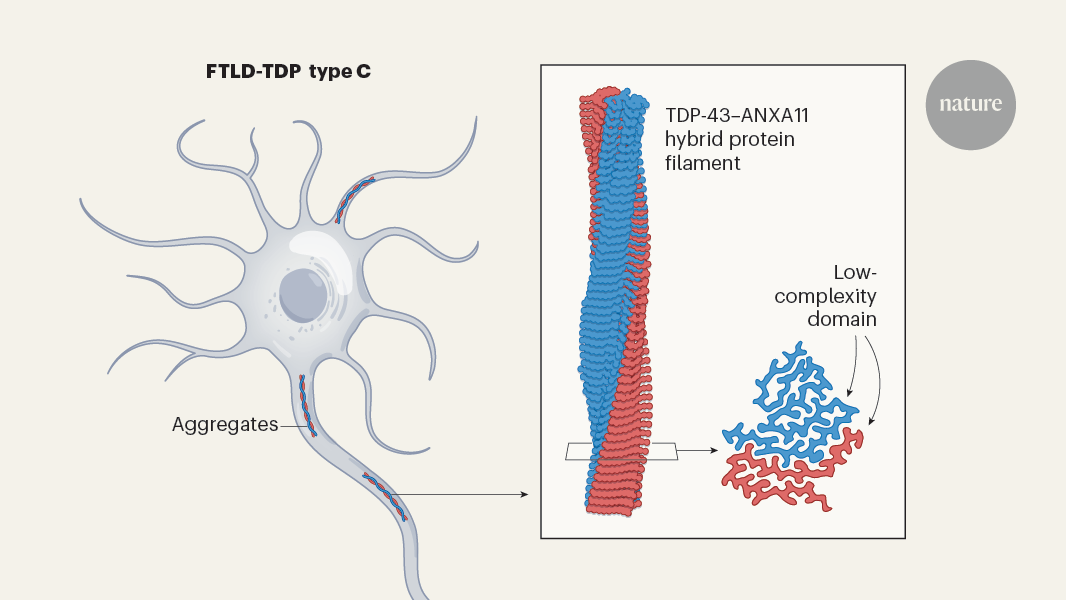Discovery of Hybrid Protein Filaments in Neurodegenerative Diseases Challenges Previous Understanding
核心概念
Neurodegenerative diseases are characterized by the aggregation of abnormally folded protein filaments in the brain, but a new study has identified the first disease-associated filament composed of two distinct proteins - TDP-43 and annexin A11.
要約
The content describes a surprising new finding in the field of neurodegenerative diseases. Traditionally, these diseases have been defined by the aggregation of protein filaments made from single types of proteins, such as tau, α-synuclein or amyloid-β. However, a recent study published in Nature has identified the first disease-associated filament composed of two distinct proteins - TAR DNA-binding protein 43 (TDP-43) and annexin A11 (ANXA11).
Using cryo-electron microscopy (cryo-EM), the researchers were able to show how fragments from these two proteins interact to assemble into helical filaments. This discovery provides new insights into the mechanistic origins of these disease-causing entities, challenging the previous understanding of neurodegenerative diseases.
The study represents a significant advancement in the field, as it suggests that the formation of protein filaments in neurodegenerative diseases may be more complex than previously thought, involving the interaction of multiple proteins. This finding could have important implications for the development of new diagnostic and therapeutic approaches targeting these hybrid protein filaments.
Hybrid protein filaments are a surprise twist in neurodegeneration
統計
Neurodegenerative diseases have been defined by the aggregation of abnormally folded protein filaments in the brain for around 100 years.
Previous structural studies of these filaments suggested they arise from ordered assemblies made from single types of protein, such as tau, α-synuclein or amyloid-β.
引用
"Using a technique called cryo-electron microscopy (cryo-EM), the authors show how fragments from these two proteins interact to assemble into helical filaments, providing hints about the mechanistic origins of these disease-causing entities."
抽出されたキーインサイト
by Michael S. F... 場所 www.nature.com 10-02-2024
https://www.nature.com/articles/d41586-024-03054-5
深掘り質問
What other types of hybrid protein filaments might be involved in neurodegenerative diseases, and how could their discovery lead to new diagnostic or therapeutic approaches?
The discovery of hybrid protein filaments, such as those composed of TDP-43 and annexin A11, opens the door to the possibility that other combinations of proteins may also form hybrid structures in neurodegenerative diseases. For instance, proteins like huntingtin, which is implicated in Huntington's disease, could potentially interact with other proteins involved in cellular stress responses, leading to the formation of hybrid filaments. Similarly, combinations of amyloid-β with tau or α-synuclein could yield novel filament structures that contribute to the pathogenesis of Alzheimer's disease or Parkinson's disease.
The identification of these hybrid filaments could significantly enhance diagnostic approaches by providing new biomarkers for early detection of neurodegenerative diseases. For example, assays that detect specific hybrid filament formations in cerebrospinal fluid or brain tissue could serve as indicators of disease progression or subtype classification. Therapeutically, targeting the assembly pathways of these hybrid filaments could lead to innovative treatments. Small molecules or peptides designed to disrupt the interactions between the constituent proteins may prevent filament formation, thereby mitigating neurodegeneration and its associated symptoms.
How might the formation of hybrid protein filaments challenge or complement the existing models of protein aggregation in neurodegenerative diseases?
The formation of hybrid protein filaments challenges the traditional models of protein aggregation, which have primarily focused on single protein types forming ordered structures. The observation that two distinct proteins can co-assemble into disease-associated filaments suggests a more complex interplay in the pathophysiology of neurodegenerative diseases. This complexity may necessitate a reevaluation of existing models, which often do not account for the potential synergistic effects of multiple proteins in aggregation processes.
Moreover, the existence of hybrid filaments could complement existing models by providing a broader framework for understanding protein interactions in neurodegeneration. It highlights the importance of protein-protein interactions and the potential for cross-talk between different aggregation pathways. This could lead to the development of integrative models that consider both single and hybrid filament formations, ultimately enriching our understanding of the molecular mechanisms underlying neurodegenerative diseases.
Could the insights gained from studying hybrid protein filaments in neurodegeneration be applicable to understanding protein aggregation in other disease contexts, such as cancer or infectious diseases?
Yes, the insights gained from studying hybrid protein filaments in neurodegeneration could indeed be applicable to other disease contexts, including cancer and infectious diseases. In cancer, for instance, the aggregation of misfolded proteins can lead to tumorigenesis, and hybrid filaments may play a role in the formation of cancer-associated protein aggregates. Understanding the mechanisms by which hybrid filaments form could provide new targets for therapeutic intervention in cancer treatment, similar to the approaches being explored in neurodegeneration.
In the context of infectious diseases, certain pathogens can hijack host cellular machinery, leading to the aggregation of host proteins in hybrid structures. For example, viral proteins may interact with host proteins to form aggregates that disrupt normal cellular functions. Insights from hybrid filament research could inform strategies to combat these pathogenic processes, potentially leading to novel antiviral therapies.
Overall, the study of hybrid protein filaments not only enhances our understanding of neurodegenerative diseases but also has the potential to inform research and therapeutic strategies across a range of diseases characterized by protein aggregation.
0
